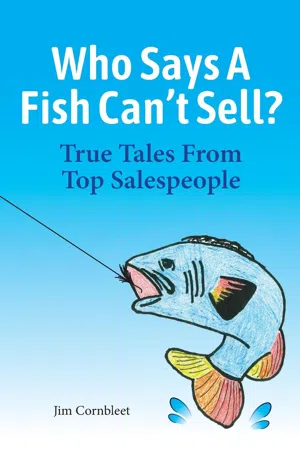
- English
- ePUB (mobile friendly)
- Available on iOS & Android
eBook - ePub
About this book
Who Says A Fish Can’t Sell?
The sales profession has been around roughly since the stone age. Archeologists have traced hunters trading for the best flint weapons and tools. No wonder that sales has long been studied, analyzed and popularized in movies and literature—from “The Music Man” to “Death of a Salesman.” In “Who Says A Fish Can’t Sell?” veteran salesman Jim Cornbleet shares what qualities shape a great salesperson through stories about memorable catches and the ones that got away.
Frequently asked questions
Yes, you can cancel anytime from the Subscription tab in your account settings on the Perlego website. Your subscription will stay active until the end of your current billing period. Learn how to cancel your subscription.
At the moment all of our mobile-responsive ePub books are available to download via the app. Most of our PDFs are also available to download and we're working on making the final remaining ones downloadable now. Learn more here.
Perlego offers two plans: Essential and Complete
- Essential is ideal for learners and professionals who enjoy exploring a wide range of subjects. Access the Essential Library with 800,000+ trusted titles and best-sellers across business, personal growth, and the humanities. Includes unlimited reading time and Standard Read Aloud voice.
- Complete: Perfect for advanced learners and researchers needing full, unrestricted access. Unlock 1.4M+ books across hundreds of subjects, including academic and specialized titles. The Complete Plan also includes advanced features like Premium Read Aloud and Research Assistant.
We are an online textbook subscription service, where you can get access to an entire online library for less than the price of a single book per month. With over 1 million books across 1000+ topics, we’ve got you covered! Learn more here.
Look out for the read-aloud symbol on your next book to see if you can listen to it. The read-aloud tool reads text aloud for you, highlighting the text as it is being read. You can pause it, speed it up and slow it down. Learn more here.
Yes! You can use the Perlego app on both iOS or Android devices to read anytime, anywhere — even offline. Perfect for commutes or when you’re on the go.
Please note we cannot support devices running on iOS 13 and Android 7 or earlier. Learn more about using the app.
Please note we cannot support devices running on iOS 13 and Android 7 or earlier. Learn more about using the app.
Yes, you can access Who Says A Fish Can't Sell? by Jim Cornbleet in PDF and/or ePUB format, as well as other popular books in Business & Sales. We have over one million books available in our catalogue for you to explore.
Information

Designed by Katemangostar / Freepik

Chapter 1
Pushing The Envelope
When you experience some success in sales, a natural progression is getting promoted to management. It’s great to be recognized for your accomplishments and take on added responsibility. I began working at Amdahl in 1987, and very quickly I helped close some big sales. The first was Monsanto in 1988, followed by General Dynamics the following year. We were on a roll, creating momentum and establishing our reputation as a major competitor in the growing market for computer processors.
I was rewarded for my tenaciousness and sales prowess by a promotion from account executive to management. That didn’t make me less focused on closing a sale. It did give me some important insight: You have to balance meeting the customer’s needs with the long-term financial viability of your own company.
A good example of this was when we closed our first sale with May Department Stores (which was acquired by Federated Department Stores in 2005 and has since been rebranded as Macy’s).
At the time, May had data centers around the country, one of which was in St. Louis where my team was located. We met on a number of occasions with the director of the data center and his staff. On our initial bid, we lost to a competitor, so we followed up by visiting May’s senior VP as a postmortem, to learn what we did right and how we could improve on the next go-round.
This process made a lot of sense. Instead of fretting about the loss and cursing the fates, we took the initiative to do better by going to the source. It demonstrated a level of maturity and a willingness to learn. One of the takeaways from that meeting was that the consumer retail business operates on a slim margin and that even the buyer we were calling on would consider buying from a competitor.
The big players like May are leaders because they squeeze every penny of profit out of their operations. I knew this because Wayne showed me a daily report once that their execs had to review—it was essentially a spreadsheet with a seemingly endless list of numbers, indicating the tight budgets they operated within. To gain a spot as a vendor, you’d better be willing to offer them a great deal.
The following year, we sized up the competition and we offered May a creative solution—a second generation processor. It would be enticing from a budget perspective and it was every bit as good as what IBM was offering. Our goal was to get our product in the door and demonstrate our commitment to service after the sale.
Things were looking up when I got an important call to meet with Wayne. He said “You’ve got this deal if you make the following adjustments to your bid.” I told him to hang on for just a minute and I walked outside his office to call my vice president, who just happened to be in town that day. I told my VP what we needed to change to close the deal and he said, “OK, let me get back to you in a few days.” I knew time was of the essence and I could close the sale if I moved quickly. I replied, “No, this is serious. We can get this deal done now!”
I walked back into Wayne’s office, and he was smiling because he heard me yelling at my VP (which, by the way, was either gutsy on my part or incredibly stupid). Fortunately, it worked out great. I got the concessions from my team and we closed the sale.
Looking back, there are a couple of interesting aspects and key lessons learned from that experience. One was the meeting we had with the customer after initially losing a bid. If a sales pitch is not working, you have to adapt. It’s all about the customer and their needs. Even when you don’t get the win, you make it a learning experience.
Another intriguing part of that process was that I had to convince two vastly different entities to agree to the terms of the sale. The May Company executives were ready to sign on the dotted line. I still had to sell my own team on the merits of landing this account.
It’s important to have the fire and passion to close a sale, which I probably demonstrated a little too dramatically that day outside the May purchasing director’s office. A year or two later I was having a drink with him, and he remembered that I yelled at my vice president. As I already mentioned, it either took guts or stupidity. Then again, a customer once told me it’s good to push the envelope.
The key takeaway and key lessons learned from this experience is if at all possible, satisfy the customer needs promptly, be transparent and let them know what you’re going through as a salesperson to satisfy their demands. At the same time, you must be cognizant that you are representing your company and you have to weigh the importance of the sale. You may take a hit on the cost of the initial sale. On the other hand, you can generate additional revenue from service and support, which is exactly what we did in this case.
“Your chances of success in any
undertaking can always be measured
by your belief in yourself.”
undertaking can always be measured
by your belief in yourself.”
– Robert Collier

Photo by Pixabay

Chapter 2
What Do You Have To Lose? A lot.
Sales can be a solitary endeavor. As the lead account executive, success or failure often comes down to your ability to understand your customer and deliver a compelling solution. I’ve been in that position on numerous occasions. And although it was my responsibility to close the sale, success from sales also includes the teams of service and support people who were ready, willing and able to provide the customer with the quality solution that was promised to be delivered.
I also have been blessed to count as friends some very fine salespeople. We learn from each other, celebrate each other’s successes and commiserate when things don’t go according to plan.
One of my best friends is also a top-notch salesperson named Patti Harty. In this chapter, I’ve asked her to share one of her memorable sales experiences that did not result in high-fives and a champagne toast. It was a sales loss, not a win. It was also a valuable learning experience for her and for anyone who aspires to succeed in this rewarding, and often humbling, line of work.
Patti never intended to go into sales. She started out in early childhood education. Then again, trying to hold the attention of a roomful of children might have been an excellent training ground and starting point for her later success. I’ll let her explain in her own words how she became a great salesperson, what she’s learned along the way, and the satisfaction she gets from her work.

My dad was in real estate sales his whole life. I never ever thought I would follow in his footsteps and go into sales. One summer I decided to get a job in the business world. At that time, I did not have any business experience, but it seemed like a good idea at age 26. And, at the time IBM was hiring like crazy so I took an employment test and I did pretty well on it. Lo and behold, they hired me. The funny thing was I joined the company on the technical side as a systems engineer, and I didn’t know anything about computers, either. I quickly realized that I was more suited to sales than technical support and made that career switch.
I also didn’t exactly look the part of a polished professional. I had big hair with a hippy vibe. My image was not that of a businesslike salesperson, but I did have one other quality that turned out to impact my sales success throughout my career. I am fiercely competitive. However, all strengths can become weaknesses, and I learned that sometimes you need to temper that need to win. Here’s what I mean.
Early on in my sales career, after my experience at IBM, I was a senior account executive for an information technology firm. I was calling on a major Fortune 500 company. The customer had recently brought on a new director and one of my challenges was to cultivate a relationship with her. The ultimate goal was to expand our services and support with the company.
We had reason to be optimistic because we had a solid relationship and a history of delivering quality training. I had already been working with a number of groups in their technology organization over the past several years. Our future looked bright. We intended to focus on gaining a stronger foothold in the training area. What possibly could go wrong?
It’s safe to say that even when you’re dealing from a position of strength, winning is not a given. The newly hired director and I had our first meeting and it started badly. Something just didn’t click. Maybe it was chemistry—or a lack of it. Perhaps I was overconfident, bordering on cocky, and just maybe I was too focused on winning to remember a sales basic: listen to the customer and understand his or her needs.
The weird thing is, developing relationships has always come easily to me. I chalked it up to the new director maybe having a bad day. Next time, I thought, I will work on this and improve the relationship. Unfortunately, that did not happen. Over the next meeting with the director, and the meeting after that, I tried to muster my abilities to develop a relationship. It just wasn’t coming together. It was too late. What doesn’t start well, doesn’t end well. And much to my chagrin, she ultimately awarded a $70,000 contract for training to another company.
In retrospect, I just didn’t do a good job of reading the customer and establishing rapport. Most of all, I should have focused on her needs. Instead, I took on a role of the expert, the role that she viewed herself, not me. It felt like we were in a challenge match. As I look back, I saw my nature of being competitive coming through, just like in tennis, and I play a lot of tennis. When I get out on the court, even with my close friends, I put on my game face and I...
Table of contents
- Cover
- Title Page
- Copyright Page
- Dedication
- Table of Contents
- Foreword
- Preface
- Chapter 1 – Pushing The Envelope
- Chapter 2 – What Do You Have To Lose? A lot.
- Chapter 3 – Professional Persistence Pays Off
- Chapter 4 – At The Five Yard Line
- Chapter 5 – Change The Rules And You Can Win Big
- Chapter 6 – Think Outside The Box
- Chapter 7 – Stay True To Your Values
- Chapter 8 – The Five Ps: Prior Planning Prevents Piss-Poor Performance
- Chapter 9 – I Thought All Salespeople Were Slimeballs
- Chapter 10 – The Fish
- Chapter 11 – What They Learned
- Chapter 12 – Epilogue: How The Sales Process Has Changed And Where It’s Going
- Appendix – Tools You Can Use
- Acknowledgments
- About the Author